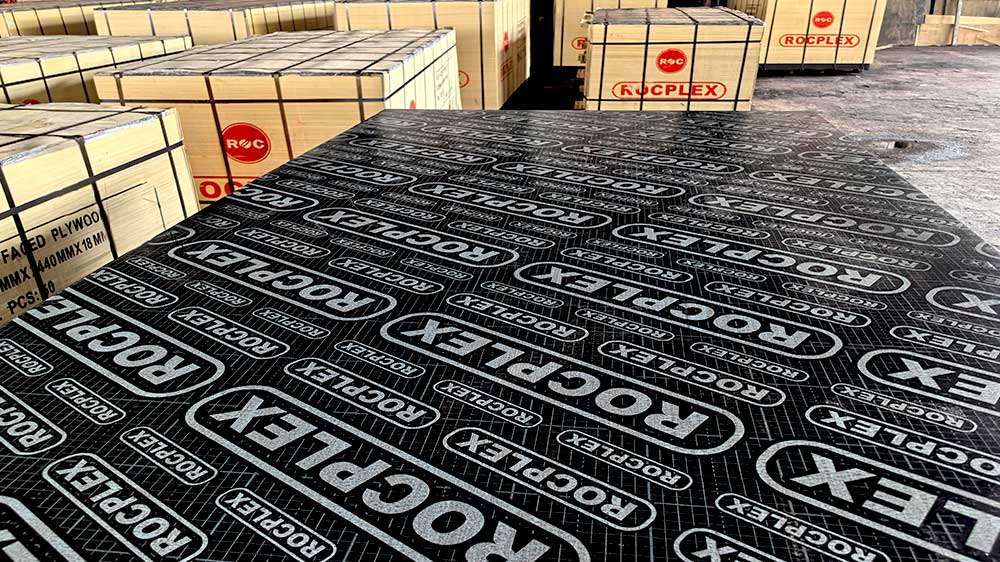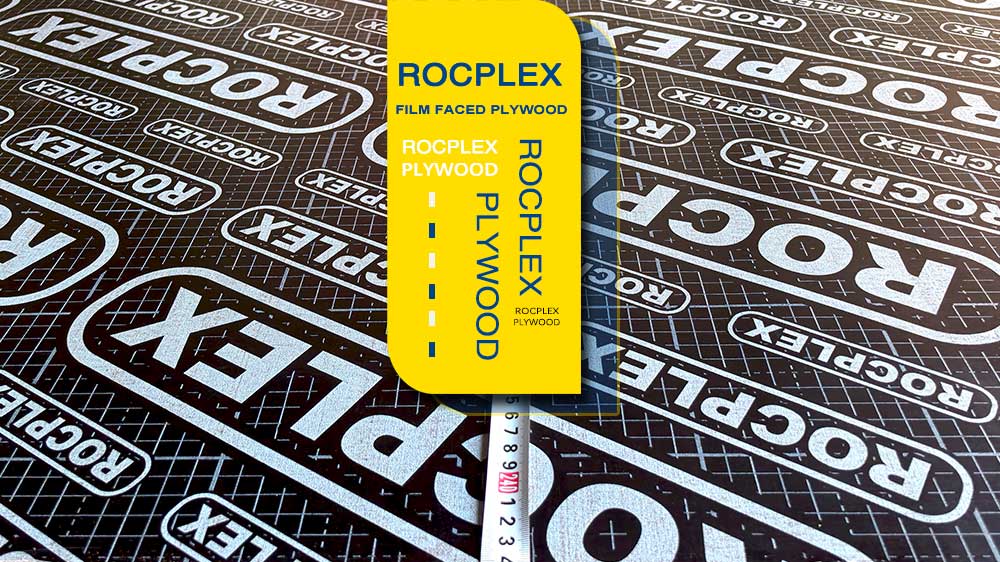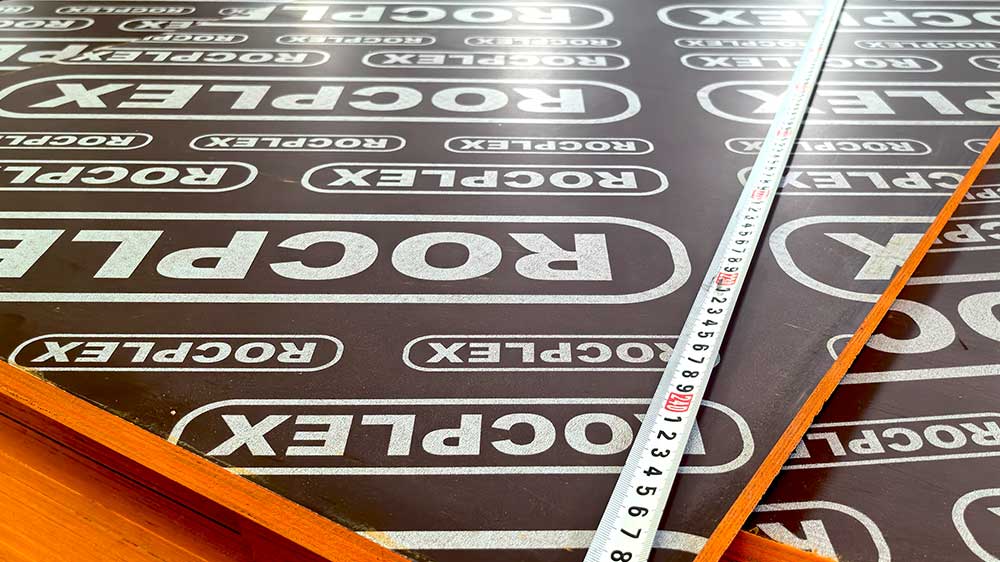What is Phenolic Plywood 3 4?
Phenolic plywood 3 4 is also known as phenolic plywood 3/4 or phenolic plywood 18mm. It is a high-performance material designed for demanding construction applications. This plywood is made by layering thin veneers of wood. These veneers are bonded together with phenolic resin. The resin gives the plywood its notable strength and durability. It also enhances resistance to water, chemicals, and heavy loads.
The phenolic resin coating on the surface adds an extra layer of protection. This feature makes the plywood suitable for outdoor use. It is particularly effective in environments exposed to moisture or harsh weather. This plywood is widely used for formwork in concrete construction. Its durability ensures reliable performance during demanding tasks. The smooth surface of the plywood guarantees a clean finish when pouring concrete.
What makes phenolic plywood 3 4 stand out is its ability to withstand repeated use without losing its structural integrity. This reusable material can handle the pressures of construction work, making it an economical choice for large projects. Whether you’re working on formwork, scaffolding, or other industrial applications, phenolic plywood 3 4 is an essential material in the modern construction industry.
Why Phenolic Plywood 3 4 is Trending in Construction
Durability That You Can Count On
If you’re looking for a material that can take on tough jobs, phenolic plywood 3 4 is the answer. Its strength and resilience are two of the main reasons it’s becoming more popular in construction. The 18mm thickness of phenolic plywood makes it ideal for heavy-duty tasks such as concrete formwork, where high load-bearing capacity and resistance to wear are crucial.
The phenolic resin coating not only adds durability but also provides protection against moisture and chemical exposure. This means the plywood can be used in environments where traditional plywood might deteriorate quickly. Whether it’s exposed to rain or construction chemicals, phenolic plywood 3 4 holds up better, making it the go-to material for tough jobs.
Water and Weather Resistance
Construction projects often take place in outdoor environments, where materials are exposed to the elements. Phenolic plywood 3 4 is designed to handle this kind of stress. Thanks to its water-resistant phenolic coating, this plywood won’t absorb moisture, which means it won’t warp, swell, or degrade over time.
This feature makes phenolic plywood ideal for projects like outdoor concrete formwork, where it needs to maintain its shape even in wet conditions. The water resistance of phenolic plywood ensures that it can be used multiple times without losing its integrity, making it a cost-effective choice for contractors.
Reusability Saves Time and Money
Another reason phenolic plywood 3/4 is trending is its reusability. Contractors can reuse phenolic plywood in formwork for multiple concrete pours, which helps reduce material costs. Since the phenolic resin protects the plywood from damage caused by water, chemicals, and wear, it doesn’t need to be replaced as frequently as standard plywood.
This reusability also saves time, as there’s no need to constantly order new materials or spend time prepping surfaces for the next use. The smooth, film-faced finish of phenolic plywood 3 4 ensures that it retains its quality over repeated cycles, which is a huge advantage for large-scale projects where efficiency is key.
Common Uses of Phenolic Formwork Plywood 3 4
Formwork and Concrete Molding
Phenolic plywood 3 4 is most commonly used in formwork for concrete construction. Its water-resistant surface and high strength make it perfect for creating molds into which concrete is poured. Once the concrete hardens, the plywood form can be removed without sticking or damaging the surface of the concrete, thanks to the smooth phenolic coating.
The thickness of phenolic plywood 3/4 provides the necessary strength to handle the weight of wet concrete while maintaining its shape. This plywood is especially useful for projects requiring large-scale concrete pours, such as the construction of buildings, bridges, and other infrastructure.
Flooring and Scaffolding
Phenolic plywood is also a popular choice for temporary flooring and scaffolding in construction sites. The 18mm thickness provides the necessary stability to support workers and equipment, while the phenolic coating ensures that the plywood remains slip-resistant and durable, even in wet or dirty conditions.
This plywood’s durability underfoot makes it a trusted material for construction sites where safety is a top priority. Its ability to withstand heavy foot traffic, as well as its resistance to moisture and chemicals, ensures that it performs well in demanding environments.
Industrial Applications
Beyond construction, phenolic plywood 3 4 is widely used in various industrial applications. Its strength and resistance to moisture and chemicals make it suitable for manufacturing environments where it may be exposed to harsh conditions. For instance, phenolic plywood is often used in the production of large containers, workbenches, and industrial flooring.
Its robust nature and long-lasting performance make it a versatile material for industrial use, where reliable and durable surfaces are essential.
Phenolic Plywood 3 4 vs. Standard Plywood: What’s the Difference?
Strength and Load Capacity
One of the main differences between phenolic plywood 3 4 and standard plywood is strength. The 18mm thickness of phenolic plywood gives it a significant advantage in terms of load-bearing capacity. Standard plywood is often not suitable for heavy-duty applications, as it may warp or fail under pressure. Phenolic plywood, on the other hand, is built to handle the demands of industrial and construction environments.
This difference in strength makes phenolic plywood ideal for applications such as scaffolding, flooring, and formwork, where stability and durability are paramount.
Resistance to Water and Chemicals
Another key distinction between phenolic plywood 3/4 and standard plywood is its resistance to water and chemicals. While standard plywood may absorb moisture and degrade over time, phenolic plywood is coated with a water-resistant resin that protects it from the elements. This makes it a far more durable option for outdoor or wet environments.
In addition to water resistance, phenolic plywood is also more resistant to chemicals, which is particularly important in construction and industrial settings where the material may come into contact with concrete, oils, or other substances.
Reusability and Longevity
Standard plywood often requires frequent replacement in high-wear environments. In contrast, phenolic plywood 3 4 can be reused multiple times. Its durability and protective coating contribute to this extended lifespan. This feature makes it a more cost-effective option for large construction projects. The initial investment is offset by reduced material replacement costs over time. This benefit is particularly valuable in demanding construction settings.
How to Work with Phenolic Plywood 3 4
Cutting and Drilling Phenolic Plywood
Working with phenolic plywood 3 4 requires the right tools. Because of its dense composition and phenolic resin coating, it’s tougher to cut than standard plywood. To achieve clean cuts without splintering, use carbide-tipped blades or saws specifically designed for cutting dense materials. Phenolic plywood can also be drilled using high-speed steel or carbide-tipped drill bits to avoid damaging the material.
For large-scale projects where multiple cuts are required, it’s important to ensure that the cutting tools are sharp and that you work at a slower pace to avoid damaging the phenolic coating.
Sealing the Edges
After cutting phenolic plywood, it’s important to seal the edges to maintain its water-resistant properties. Although the surface of the plywood is coated with phenolic resin, the exposed edges need additional protection to prevent moisture penetration. Using a waterproof sealant on the cut edges will ensure that the plywood remains durable and resistant to water.
This is especially important for outdoor applications where the plywood will be exposed to rain or humidity. Properly sealing the edges will extend the lifespan of the material, making it more cost-effective in the long run.
Fastening and Attaching Phenolic Film Faced Plywood
When fastening phenolic film faced plywood to other materials or structures, screws are the preferred method of attachment, as they provide a stronger hold than nails. Pre-drilling holes before screwing into the plywood is recommended to avoid cracking or splitting the material. Construction adhesives can also be used in combination with screws to create a more secure bond, particularly for applications like flooring or formwork where stability is critical.
Phenolic Plywood 3 4 in Industry Trends
The Growing Demand for Durable Materials
The construction and industrial sectors are always on the lookout for materials that are durable, cost-effective, and efficient. In recent years, phenolic plywood 3 4 has gained significant traction due to its long-lasting performance and versatility. As industries continue to prioritize efficiency and sustainability, the demand for materials that reduce waste and can be reused multiple times is rising.
Phenolic plywood, with its reusability and resistance to environmental stressors, fits perfectly into this trend. As construction projects become more complex and environmentally conscious, the need for reliable materials that minimize the need for replacements is greater than ever. Phenolic plywood’s ability to withstand multiple uses without deteriorating contributes to its growing popularity.
Eco-Friendly Construction Solutions
Sustainability is a growing concern across industries, and construction is no exception. Contractors and builders are increasingly leaning toward materials that reduce environmental impact, both in terms of production and usage. Phenolic plywood 3/4 aligns with these goals by offering a material that is not only strong and reliable but also reusable.
The use of phenolic plywood in formwork, for example, significantly reduces the amount of waste generated on construction sites. Phenolic plywood allows for multiple uses of the same sheets. This reduces the need for frequent replacements. As a result, it lowers the demand for new resources. Its resistance to weather and chemicals further extends its life cycle. This durability aligns with the industry’s focus on sustainability. By lasting longer, phenolic plywood helps reduce material waste. It supports efforts to promote environmentally friendly practices.
The Role of Phenolic Film Face Plywood in Prefabricated Construction
Another industry trend that has boosted the popularity of phenolic plywood 3 4 is the rise of prefabricated construction. Prefabrication involves constructing parts of a building off-site and then assembling them on location. This method saves time, reduces costs, and minimizes the environmental impact of construction projects.
Phenolic plywood is a perfect fit for prefabrication because of its strength, durability, and ease of handling. Its resistance to moisture and chemicals makes it suitable for creating prefabricated panels that can withstand transportation and installation. As prefabrication continues to grow in popularity, phenolic plywood 3/4 is likely to play an even more significant role in modern construction techniques.
Phenolic Plywood 3 4: A Versatile Choice Across Industries
Infrastructure and Civil Engineering Projects
Infrastructure projects like bridges, tunnels, and dams require materials that can handle extreme conditions and heavy loads. Phenolic shuttering plywood 3 4 is well-suited to such projects due to its exceptional strength and durability. Its ability to maintain its form under pressure makes it a critical component in the construction of formwork for large-scale infrastructure projects.
Phenolic plywood is not only strong but also water-resistant. These properties make it particularly valuable in civil engineering projects where exposure to moisture is inevitable. It is ideal for pouring concrete in damp environments. It is also suitable for constructing scaffolding in wet conditions. Phenolic plywood ensures that the job is done without compromising the quality or integrity of the structure. By resisting moisture and maintaining its strength, it provides reliable performance even in challenging conditions.
Marine and Automotive Industries
Phenolic plywood is not just limited to construction; it also finds applications in the marine and automotive industries. Its resistance to moisture, chemicals, and wear makes it a preferred choice for boat building, where it is used for flooring, decking, and paneling. The 18mm thickness provides the necessary durability for marine environments, where materials are frequently exposed to water and salt.
In the automotive sector, phenolic plywood is used in vehicle interiors and cargo areas, particularly for commercial trucks and trailers. Its strength, combined with its resistance to impact and moisture, makes it ideal for these high-wear environments. As industries continue to innovate, phenolic plywood’s adaptability to various applications ensures its place in a wide range of sectors.
Interior Design and Architectural Uses
While phenolic plywood 3 4 is known for its industrial applications, it’s also becoming increasingly popular in interior design and architecture. Its smooth, film-coated surface makes it an attractive material for modern and minimalist designs. It can be used for wall paneling, partitions, and even furniture.
Phenolic plywood’s clean, polished look adds a sleek finish to interiors while providing the added benefit of durability. Architects and designers appreciate its ability to withstand heavy use without showing signs of wear, making it a practical and aesthetically pleasing choice for public spaces like offices, hotels, and retail environments.
How to Maximize the Lifespan of Phenolic Plywood 3 4
Proper Storage and Handling
To get the most out of your phenolic plywood 3/4, proper storage and handling are essential. When not in use, plywood sheets should be stored in a dry, covered area to protect them from moisture and direct sunlight. Storing the sheets flat is important to prevent warping or bending over time.
Handling phenolic plywood with care is also key to maintaining its integrity. Although the phenolic coating is durable, sharp impacts or improper stacking can cause damage. By taking the time to handle and store the plywood correctly, you’ll ensure that it remains in good condition for multiple uses.
Maintenance and Cleaning
Regular maintenance can also extend the life of phenolic plywood. After use, particularly in formwork applications, the plywood should be cleaned to remove any concrete residue or dirt. A simple wash with water is usually enough to keep the surface clean, but it’s important to avoid using harsh chemicals that could degrade the phenolic coating.
For industrial applications, phenolic plywood is often exposed to chemicals, oils, or other contaminants. Regular cleaning ensures the material remains in top condition. Keeping the surface clean helps maintain its performance over time. Addressing any signs of wear early can further extend its usability. This proactive care maximizes the cost-effectiveness of phenolic plywood. Proper maintenance ensures it continues to deliver reliable results in demanding environments.
The Future of Phenolic Plywood 3 4
Innovations in Material Technology
The construction and industrial sectors are constantly evolving, and material technology plays a huge role in these advancements. As the demand for stronger, more durable, and environmentally friendly materials grows, innovations in phenolic plywood are likely to continue. Manufacturers are developing new types of phenolic coatings that offer even greater resistance to wear and environmental stressors, making phenolic plywood an increasingly attractive option for a wide range of applications.
In addition to improved coatings, the manufacturing processes for phenolic plywood are becoming more efficient and sustainable. This not only reduces the environmental impact of production but also makes phenolic plywood more accessible to a wider range of industries.
Expanding Applications Beyond Construction
While construction remains the primary industry for phenolic plywood 3/4, its applications are expanding into new areas. As industries like marine, automotive, and interior design continue to grow, the versatility and durability of phenolic plywood will allow it to serve new and innovative purposes.
From custom furniture to advanced transportation solutions, phenolic plywood 3 4 has the potential to revolutionize how we think about materials in both traditional and cutting-edge industries. As technology advances, so too will the possibilities for using this remarkable material in creative and unexpected ways.
Phenolic Plywood 3 4 FAQs
Q: How many times can phenolic plywood 3 4 be reused in formwork?
A: Phenolic plywood 3 4 can be reused multiple times in formwork applications, depending on how well it’s maintained. Regular cleaning and proper storage can extend its usability.
Q: Is phenolic plywood suitable for outdoor use?
A: Yes, phenolic plywood is highly resistant to water and weather conditions, making it suitable for outdoor construction projects and industrial applications.
Q: What are the main advantages of phenolic plywood 3 4 over standard plywood?
A: Phenolic plywood 3 4 offers superior strength, water resistance, and durability. Its phenolic resin coating protects it from moisture and chemicals, making it ideal for heavy-duty tasks.
Q: Can phenolic plywood be used in marine environments?
A: Yes, phenolic plywood’s water-resistant properties make it suitable for use in marine environments, such as boat building and docks.
Q: How should I cut and work with phenolic plywood?
A: Use carbide-tipped blades and drill bits to cut phenolic plywood, as its dense composition requires sharp, high-quality tools. Pre-drilling is recommended to avoid splitting.
Phenolic plywood 3 4 is a versatile, durable material that excels in construction, industrial, and even marine applications. Its superior strength, water resistance, and cost-effective reusability make it a popular choice for contractors and industries looking for reliable, high-performance materials. As trends in construction and sustainability continue to evolve, phenolic plywood 3 4 is poised to remain a key player in the industry.
Post time: Nov-16-2024




